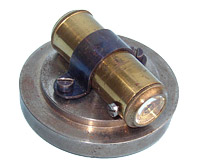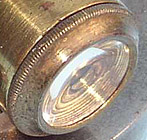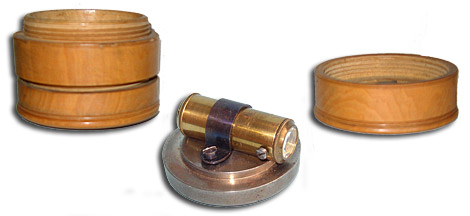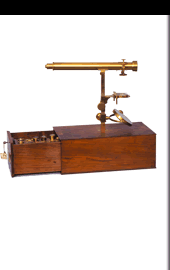Instruments
Level
In London in 1827 Amici met among others Captain Henry Kater (1777-1835), mathematician and man of science, member of the Royal Society, who had worked at length on surveying in India. Only two years before the “Philosophical Transactions” had published the description of his collimator (The description of a floating Collimator), and this had brought to Amici the idea of a float over mercury with a telescope.
 On 29 January 1829 he read Descrizione di un nuovo Istrumento per livellare (Description of a New Levelling Instrument) at the Modena Royal Academy of Sciences, Letters and Arts. It was published only in 1837 in Vol. XV of the “Atti della R. Accademia economico-agraria dei Georgofili di Firenze” (download pdf).
On 29 January 1829 he read Descrizione di un nuovo Istrumento per livellare (Description of a New Levelling Instrument) at the Modena Royal Academy of Sciences, Letters and Arts. It was published only in 1837 in Vol. XV of the “Atti della R. Accademia economico-agraria dei Georgofili di Firenze” (download pdf).
The floating level of Amici “is based on the same principal of Kater’s collimator. But while this latter can only be used in fixed observatories for determining the numbering principle of astronomical circles, Amici’s level is so disposed that it can be used easily and safely for minor topographic levelling and in agriculture. It is a small Galilean  telescope fixed on a iron wheel which floats on mercury in a small wooden box. Prior to Amici the Galilean telescope could not be set on any mathematical instrument because the threads of a reticule could not be seen in it. Amici has compensated for this defect by constructing the eyepiece of his telescope convex at the edges and concave only in a very small central space. For this reason the threads of the reticule are visible in that portion of the pupil which takes in the convex part while at the same time for the central part the pupil sees the outside objects enlarged” (Giovanni Battista Donati, Elogio del Prof. Gio. Battista Amici, Cellini, Florence 1865, p. 17).
telescope fixed on a iron wheel which floats on mercury in a small wooden box. Prior to Amici the Galilean telescope could not be set on any mathematical instrument because the threads of a reticule could not be seen in it. Amici has compensated for this defect by constructing the eyepiece of his telescope convex at the edges and concave only in a very small central space. For this reason the threads of the reticule are visible in that portion of the pupil which takes in the convex part while at the same time for the central part the pupil sees the outside objects enlarged” (Giovanni Battista Donati, Elogio del Prof. Gio. Battista Amici, Cellini, Florence 1865, p. 17).
 The drawing of the instrument is taken from Beschreibung eines neuen Nivellir-Instruments, erfunden von Hrn. Amici, “Annalen der Physik und Chemie”, hrsg. von J. C. Poggendorff, 28. Band - 1833.
The drawing of the instrument is taken from Beschreibung eines neuen Nivellir-Instruments, erfunden von Hrn. Amici, “Annalen der Physik und Chemie”, hrsg. von J. C. Poggendorff, 28. Band - 1833.
The level pictured here can be found at the Ximeniano Observatory in Florence and was probably made by Amici as ordered by Fr. Eusebio Giorgi on 14 May 1839.
Another example is kept in the Museum of the Institute of Physics at the University of Siena.

